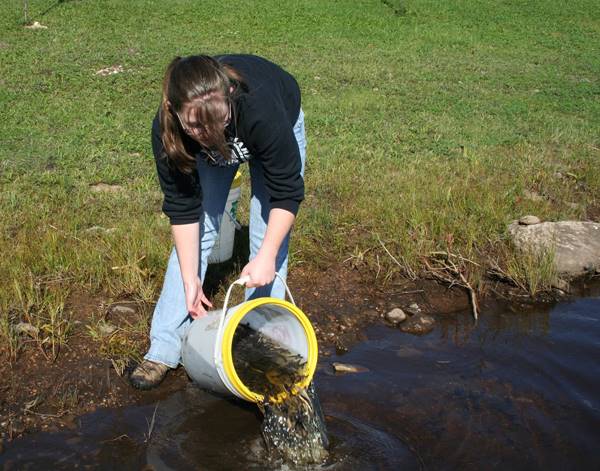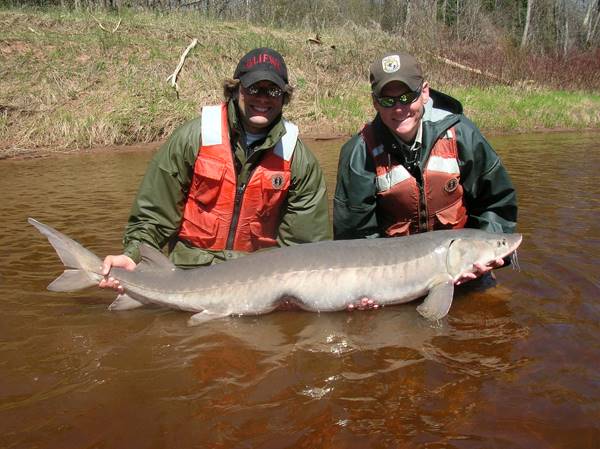Michigan lake sturgeon stocking aims to restore culturally important Great Lakes fish
All bony plates and ridges, sometimes topping six feet and 200 pounds, the lake sturgeon swimming around the Great Lakes today look about the same as the ones that lived alongside the Cretacean dinosaurs more than 136 million years ago. Long lineage is no defense against overfishing, however, and around the turn of the 20th century the lake sturgeon suffered losses at the hands of overzealous anglers.
The Michigan Department of Natural Resources stocked nearly 6,000 juvenile lake sturgeon in the state’s waters over the summer and into the fall in an effort to restore one of the Great Lakes’ most interesting species.
“This is not traditional stocking,” said Ed Baker, researcher station manager with the Michigan DNR. “Our primary goal with sturgeon stocking is to establish sturgeon populations where they formerly existed.”
Achieving that goal requires a unique approach to fishery management. Rather than farm-raising the fish and releasing them into understocked waterways, managers rely on existing lake sturgeon to spawn naturally in the river. When the eggs hatch, and the larvae are ready to feed, they’re caught and taken to streamside hatcheries, where they’re raised in the same water from which they were removed. Once the sturgeon grow to a length of seven inches, they’re tagged and released.
“We want the fish to come back in 30 or 40 years when they spawn, so they need to imprint,” Baker said. Like salmon, young sturgeon develop an olfactory imprint of their birthplace that guides them back when they’ve reached sexual maturity.

Fisheries technician Emily Martin stocks sturgeon in the Whitefish River in Michigan’s Upper Peninsula. (Credit: Michigan DNR)
The DNR stocked sturgeon in nine rivers and lakes across Michigan, in groups as small as 35 and as large as 2,102 fish. The math behind the placements is admittedly less than analytical, according to Baker.
“We’ve sorta been flying by the seat of our pants in terms of what numbers of sturgeon to stock, because we don’t have any long-term studies,” Baker said.
“We do know we don’t have to stock a lot of them,” he added. “If we’re able to stock just a few hundred fish in a river every year, in 20 or 25 years then we’ll be able to repopulate that river.”
DNRs across the country stock fish on an annual or semi-annual basis to keep popular sport species available for recreational anglers. While the sturgeon is notable as a recreational target, Native American communities around the Great Lakes hold the fish in especially high regard. Written accounts from early European explorers even mention the importance of the species to America’s native peoples.

Juvenile lake sturgeon growing in a tank before stocking in Michigan waterways. (Credit: Michigan DNR)
Two native groups, the Little Traverse Bay Band of Odawa Indians, and the Little River Band of Ottawa Indians, helped the Michigan DNR stock sturgeon on the Big Manistee River and the aptly named Sturgeon River. But neither of those fisheries draw crowds like Black Lake.
“The most popular fishery we have is on Black Lake,” Baker said. An annual spear harvest has been held there since the 1940s. “To the folks around that region, [sturgeon] are very culturally important as well as economically important.” Lake St. Clair and the St. Clair River are also gaining traction among sturgeon anglers.
The DNR said in a press release that the stocking efforts have served a second function: to inform the public about lake sturgeon and their role in Michigan’s lakes and waterways. As public awareness of this species grows, so too will the sturgeon’s chances for success. And successful rehabilitation of the sturgeon could be a great thing for the Great Lakes, Baker said.
“Lake sturgeon are threatened throughout their entire range,” Baker said. “We want to return them to their place of importance in the Great Lakes ecosystem. We want to get these fish off the threatened species list.
“If we’re able to do that, we’ll be able to know that the Great Lakes are in a healthier condition.”




Pingback: FishSens Magazine | The History of Fish Trafficking in the Great Lakes - FishSens Magazine